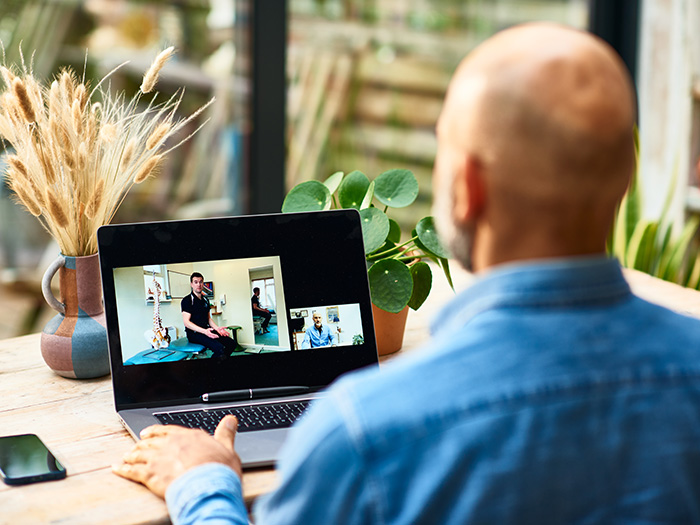Sponsored: Bardavon Health Innovations
Why a Mix of In-person Therapy, Virtual Coaching and Self Care Are Key to Helping Workers Recover from Musculoskeletal Injuries

Musculoskeletal (MSK) injuries are the leading cause of work-related injuries and disability. The effectiveness of treatment and success of recovery from those injuries relies heavily on the mindset of the individual patient.
Often these injured workers are overwhelmed by the prescribed treatment regimen and confused by their role in their own recovery. Additional stressors such as anxiety about physical pain, lost wages, and an intimidating claims process can have secondary impacts that a practitioner cannot always discover but can impede successful recovery.
A worker who is anxious or not trying to (safely) push through pain to get back to work quickly may take longer to heal or face reinjury upon returning to work. While in-person care remains at the center of treating MSK injuries, ignoring what a patient can achieve at-home through supplemental self-care and wellness practice can be detrimental to their return to work and long-term health.
“After personally treating injured workers for 10 years, many injured workers have shared they feel very left behind by the workers’ compensation space today. They feel uninformed, scared, and they feel like they’re an afterthought to the process itself,” said Dorothy Riviere, chief clinical officer of Bardavon Health Innovations.
“Putting a face on each injured worker is key to providing quality physical therapy care to get patients back to work.”

Dorothy Riviere, Chief Clinical Officer, Bardavon Health Innovations
That’s why physical therapists treating workers’ compensation patients need to approach care from a whole-person perspective and treat each case as a unique individual, instead of simply a body part or injury.
Digital tools can supplement in-person therapy to aid injury prevention, recovery, and post-injury maintenance. Remote monitoring and virtual coaching can integrate with clinical treatment, helping practitioners monitor a patients’ progress and adjust treatment regimens, enhancing claims stakeholder communication and providing near real-time information about the patient.
This holistic approach also can help overcome patient anxiety through pain management and mindfulness strategies to help workers with their physical therapy exercises in the home, helping them achieve better outcomes.
Understanding the importance of the whole-person approach to recovery, Bardavon acquired PeerWell, an MSK digital care startup that shared that same dedication to holistic patient care.
The acquisition builds on Bardavon’s existing clinical technological capabilities and national network of over 22,000 physical and occupational therapists, intending to simplify the workers’ comp physical therapy process and improving outcomes for any MSK injury, avoiding readmissions and riskier surgical treatments for patients who want to return to work.
The Five Pillars of Health
Central to a whole-person approach to care are the five pillars of health PeerWell places at the center of its treatment plans: physical therapy, nutrition, pain and wellness, life management and health literacy.
“It’s a 360-degree care experience,” Riviere said. “We’re surrounding this person, who now has an MSK injury, with a range of services and support, and the ability to connect with how to actually improve in a way that they didn’t have before.”
PeerWell’s services are designed to allow injured workers to take what they learn during their in-person physical therapy appointments into their homes. Riviere said the solution offers mobility tracking, so that patients can measure their range of motion before and after at–home exercises. This system can create a feedback loop that motivates patients to continue their exercises at home and be empowered by seeing progress.
“This allows the care to continue as opposed to being siloed to simply the visits that they attend,” Riviere said. “The therapy provider will now understand what activities the person is doing at home, how often and what progress is made extending care visibility into the home. This extends the knowledge and the feedback loop for therapy providers and the patient, and each clinical visit begins to build upon itself.”
Additionally, some of the mental health resources offered in the app will help workers address the behavioral health components of their injury such as fear and anxiety.
“Being able to address the complexity of the emotions and the mental stress that a person experiences with a work injury allows us to start to manage those aspects with a very easy to use, simple, educational approach,” Riviere said.
“We understand that you are experiencing a physical issue, but we know that impacts more than just your ability to use your arm, your ability to use your leg. It impacts you. It impacts your ability to earn a living. It impacts your ability to provide for your family and maybe even do things at home too. We recognize it. And we help you address that as well.”
Improving Stakeholder Communication
It’s no secret that workers’ comp physical therapy is more complicated than commercial health physical therapy. In a workers’ comp claim, many different people are a part of the process.
A historical challenge has been keeping everyone who is working on behalf of an injured worker connected and sharing information while keeping the injured worker as the central focus.
One key to improving this communication between stakeholders is better data exchange and richer clinical data quality. Riviere said that apps like PeerWell and Bardavon’s clinical bNOTES® software allow all stakeholders in a claim to see an injured worker’s treatment plan and track progress in near real-time.
This ensures that everyone involved in a claim is on the same page. Hence, the patient benefits through improved care quality and relieving the anxiety burden that can result from a complicated claim process.
How Bardavon Leverages Technology for Better Outcomes
All these tools play a critical role in Bardavon’s central mission: individualizing every injured worker to improve mobility and recovery. Each person is different, and each patient’s response to treatment is different.
Bardavon’s cloud-based clinical software, bNOTES, is designed specifically to manage workers’ compensation physical therapy. It supports the practitioner in managing patient progress through data insights. Pairing the information from a therapist in Bardavon’s nationwide network with the information provided by the PeerWell suite of at-home and patient monitoring tools creates a complete picture of the patient, a capability previously unavailable in the market.
“In workers’ compensation, the move to digital has been a little bit slower than on the commercial health side, where virtual telemedicine, and tele-rehab visits have increased during the COVID pandemic,” Riviere said.
“At the point of care, we are now guiding the interaction between the therapy provider and the injured worker and collecting normalized clinical treatment data, which allows us to immediately understand what’s going on with that patient and intervene when necessary,” she said.
“We believe the future of health is personalized and integrated, and we are expanding our digital health platform to do just that.”
To learn more, visit: https://www.bardavon.com/.
This article was produced by the R&I Brand Studio, a unit of the advertising department of Risk & Insurance, in collaboration with Bardavon Health Innovations. The editorial staff of Risk & Insurance had no role in its preparation.










